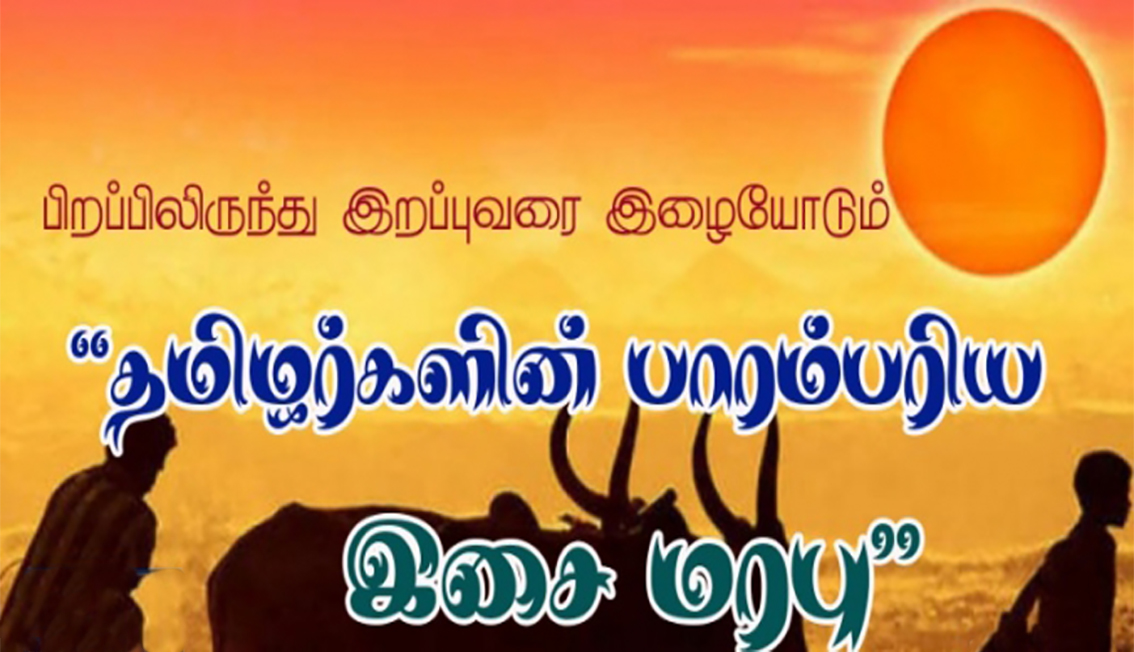

Tamil Music

Music of Tamil has a long tradition and history going back thousands of years. Music is a very important aspect of marriage and temple festival Tamil people.
Ancient music
The tradition of Tamil music goes back to the earliest period of Tamil history. Many poems of the Sangam literature, the classical Tamil literature of the early common era, were set to music. There are various references to this ancient musical tradition found in the ancient Sangam books such as Ettuthokai and Pathupattu. The early narrative poem Cilappatikaram, belonging to the post-Sangam period also mentions various forms of music practiced by the Tamil people. Music was also utilised in the compositions of the Tamil Saiva saints such as Appar, Thirugnana Sambanthar and Manikkavasagar during the Hindu revival period between the sixth and the tenth centuries CE.
Sangam music
The Sangam age grammatical work Tolkappiyam mentions the various music pertaining to the five landscapes (thinai) of the Sangam literature. The five landscapes are associated with a mood of the poem and to give colour to these moods, each had a musical mood (pann), a melodic instrument (yaazh) and a percussion instrument (parai). For example, the neithal thinai, which dealt with the incidents around the seashore and the theme of elopement, had the musical mood of sevvazhi, Vilari yaazh as the musical instrument and the navayapambai for the percussion.
Musical instruments
Poems of the Sangam literature contain numerous mentions of the various musical instruments such as the Seerkazhi , a stringed instrument of the Veena type and various percussion instruments such as murasu or muzham. Pattupattu contains a description of the yazh, a stringed instrument.
Yaazh
There were two types of yaazh, Periyaazh or the ‘large yaazh’ contained 21 strings, whereas its more compact companion ‘senkottu Yaazh’ had only seven strings. The other types of yaazhs, Makarayaazh with 19 strings and Sakottuyaazh with 14 strings and Seeriyaazh with 7 string are also mentioned in Pattuppattu.
Flute
The flute was the most popular wind instrument during the Sangam period. Perumpanarruppatai, one of the Pattupattu anthologies, describes the process of making the flute. The holes in the bamboo tube were bored using red-hot embers. The flute is also mentioned in the Kurincippattu as the instrument on which the shepherds played the ambal pann.
Murasu
The Murasu, or the drum was the most popular percussion instrument. During festivals, the sound of Murasu conveyed joy and gaiety. Muzhavu, another percussion instrument accompanied singers. The drum was also used as the war-drum, calling people to arms. Mathuraikkanci mentions that the murasu was one of the prized possessions captured from the defeated enemy in the battlefield.
Musical notations
In Tamil music, the sargam “sa-ri-ga-ma-pa-da-ni” of the Indian classical music were known by their Tamil names Kural, Tuttam, Kaikilai, Uzhai, Ili, Vilari and Taram. There are notations for the notes in different octaves. For example, Kurai Tuttam and Nirai Tuttam refer to the ri (rishabha) note in the lower and upper octaves respectively.
Moods
Raga, which defines the mood of the Indian classical music was described by the Pann. Specific panns were sung during worship and during religious and royal ceremonies. Maduraikanchi refers to women singing Sevvazhi pann to invoke the mercy of God during childbirth. In Tolkappiyam, the five landscapes of the Sangam literature had an associated Pann, each describing the mood of the song associated with that landscape.
Post-Sangam music
“The south Indian music system, which was indeed Tamil Pannisai, was erroneously named, for the first time, Karnataka sangeetham in the 12th century by a western-Chalukya king, Someswara Bhuloka Mamalla, in his ‘Manasoullasam’, a monumental work that dealt with all the subjects under the sun, including music. In no other language in India, there existed at that time Sahityas (musical compositions) as they did in Tamil. Though most of the music manuals written from the 9th century onwards were in Sanskrit, the source materials for them — like the varieties of ‘ragas’ ( pann) they had mentioned in their works — were all associated with the Tamil literary works, like ‘Silappadikaram’, ‘Thevaram’, and ‘Nalayira Divya Prabhandam’..”
Pannisai (Carnatic Music)
Pann, which is the classical music form of Southern India, has a long history in Tamil Nadu. Later the name was mistakenly changed as Carnatic music. Even today Pannisai is sung in temple festivals. Tamil Nadu has produced several famous performers, as well as a closely related classical dance form Bharatha Natyam. Chennai hosts a large cultural event, the annual Madras Music Season, which includes performances by hundreds of artists.
There are 72 basic scales on the octave, and a rich variety of melodic motion. Both melodic and rhythmic structures are varied and compelling. This is one of the world’s oldest and richest musical traditions. Songs have been composed by great artists and handed down through generations of disciples.
Folk music
Folk singing remains popular, especially in rural areas; elements of the traditional styles are sometimes used in film music. There are contemporary enthusiasts, like Vijayalakshmi Navaneethakrishnan and Pushpavanam Kuppuswamy, who have worked to revive popular interest in the folk music of Tamil Nadu. The urumee mellam also remains as one of the more popular forms of folk music in rural Tamil Nadu and the ensemble is most often played with an urumee and the nadaswaram as the instrument of choice.
The rural hill tribes of Tamil Nadu each have their own folk traditions. The Pulayar, for example, perform melodies called talams which are said to come from the cooing of birds. Each talam is named after a deity, including Kunhanada talam, Mangalanada talam and Karaganachi talam.